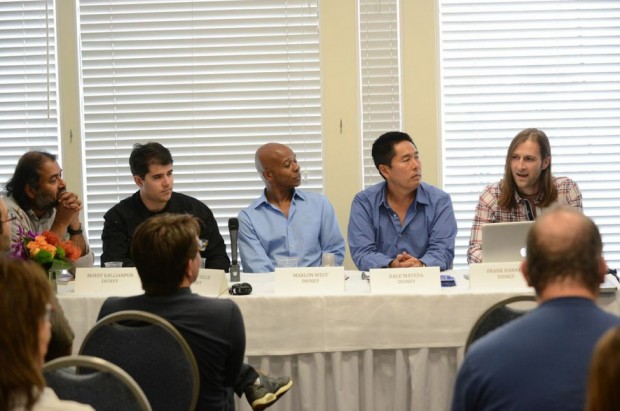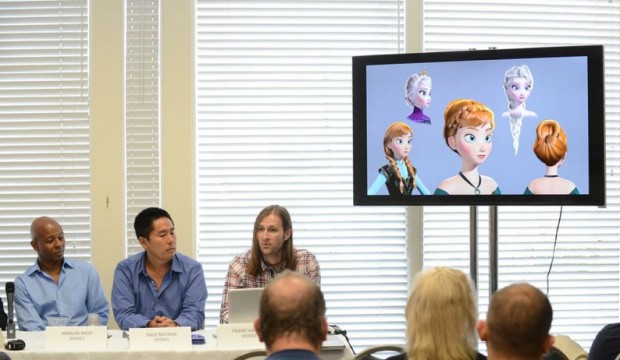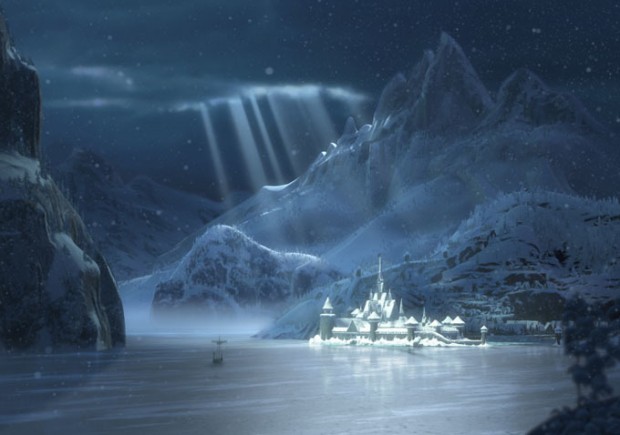Visitors to the World Animation & VFX Summit in Marina Del Rey this week were given a wintery treat despite the warm So Cal weather on Tuesday as key crew from Disney’s upcoming CG feature Frozen (out November 27) gave a behind-the-scenes look at the technical and artistic challenges of the film’s production. Presenting were lighting director Mohit Kallianpur, software engineer Andrew Selle, CG supervisor Frank Hanner and effects supervisors Marlon West and Dale Mayeda.
Hanner took the audience through the rigging challenges the CG team faced, and revealed that Frozen boasts big numbers in this department: 312 character rigs, 245 clothing rigs and 63 hairstyle rigs — more than on any other film before, with the clothing figure more than doubling over any previous Disney film. And if you thought Rapunzel’s mane in Tangled was complex, it’s interesting to note that Snow Queen Elsa has 240,000 hairs on her head (about 24 times what a normal human boasts), while the longer-tressed heroine had only 27,000. Tools developed to aid these various rigs include Tonic, which allowed for a sculptural approach to hair grooming that allowed artists to easily create the elaborate, Scandinavian style braids seen in the film; and Flourish, a “faux-dynamics” system to give in-scene soft overlap and jiggle (ex: jostling the stirrups on a horse’s saddle as it moves). The crew also came up with a new system called Spaces to tackle the challenge of the snowman Olaf’s no-rules behaviors.
Major elements of the film are the icy effects crucial to the storyline, which are tied in with Elsa’s character and cover the landscapes our heroes traverse. The effects and software teams studied the various qualities and behaviors of snow, and even brought in a “snow expert” professor from CalTech. Small but important touches like a program that could grow unique snowflakes (about 2,000 unique flake designs appear in the film) in an organic manner following the rules of nature, new systems for physics and simulations to help the characters interact with deep snow were among some of the amazing technical breakthroughs the team detailed during the presentation. The effects supes emphasized that they wanted to go for “believability” over stark realism, while reflecting the film’s Scandinavian design elements as much as possible.
Also fascinating was Kallianpur’s in-depth explanation of how the lighting & look department spent countless hours examining the reflective and refractive qualities of snow and ice–especially crucial for the Ice Palace Elsa builds for herself. In addition to using practical light set ups on blocks of ice on a sound stage, the team traveled to colder climes to photograph and study things like the Ice Hotel in Quebec, which proved especially useful to the team due to the variety of surface textures and lighting used in its architecture. While it took a little work to get the Ice Palace to look less “acrylic” (as John Lasseter put it during a test review), the crew eventually found the right balance of organic textures and saturated light that brought the right blend of magic and believability to Frozen‘s icy world.
Disney’s Frozen will open in theaters on November 27. For an in-depth look at the making of the movie, pick up this month’s issue of Animation Magazine.







 Win a Funko X Lilo & Stitch Prize Pack!
Win a Funko X Lilo & Stitch Prize Pack! 
